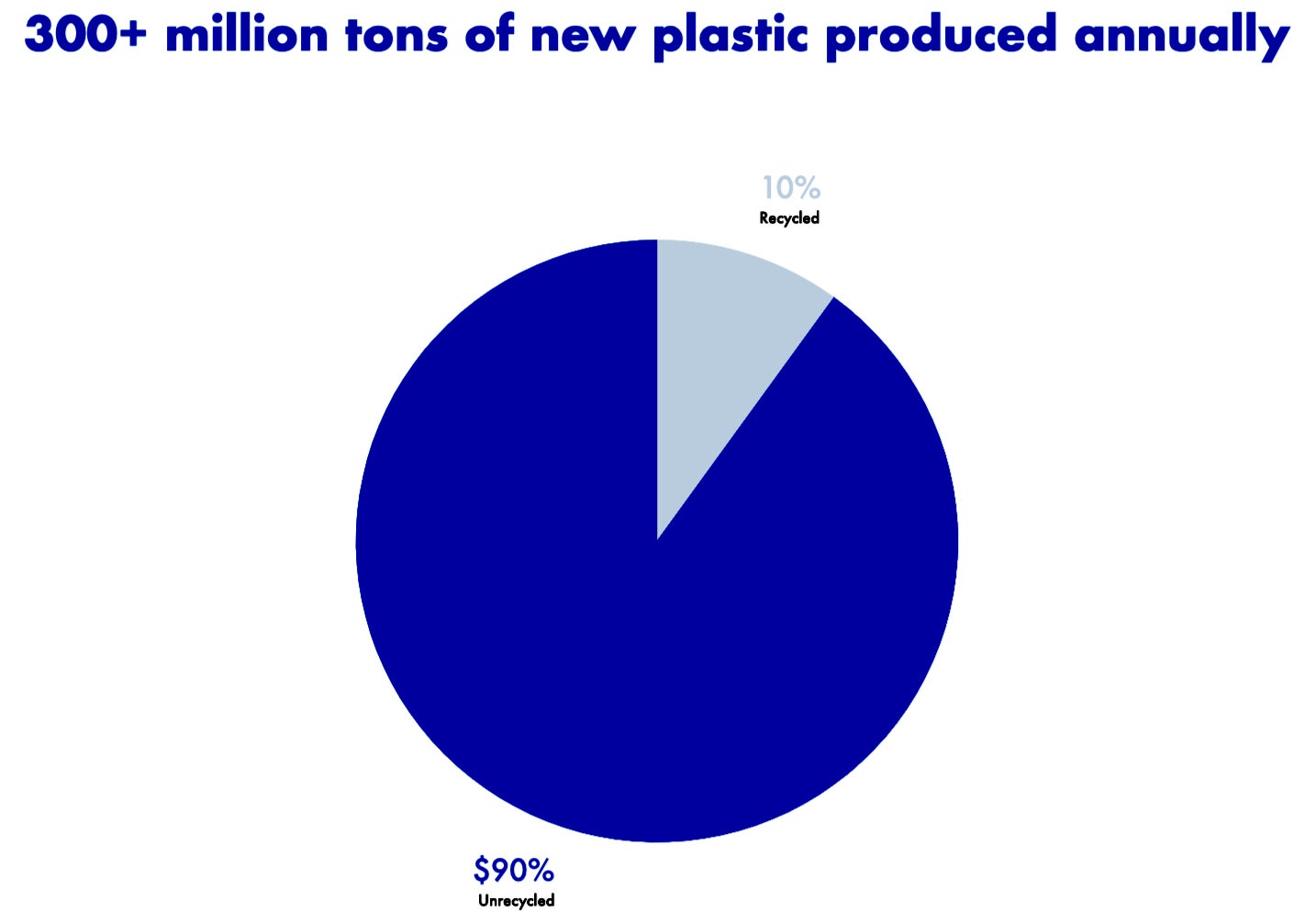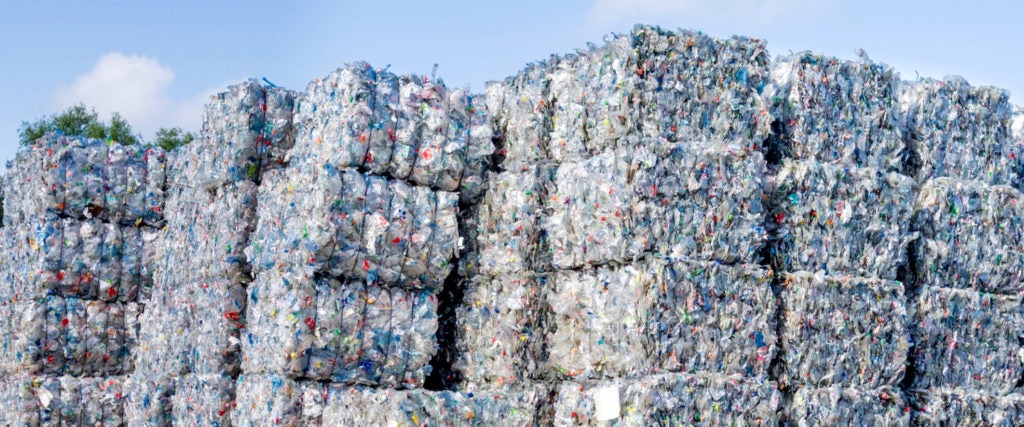July 11, 1907, was a big day in the history of unintended consequences. It was when Belgian chemist Leo Baekeland figured out how to synthesize a moldable, near-indestructible material cheaply from formaldehyde and phenol — Bakelite, as he would call the world’s first wholly synthetic plastic. To mark the occasion, he jotted this in his diary: “Unless I’m very much mistaken, this invention will prove important in the future.”
Not his fault, perhaps, but with a little over a century’s hindsight, that now sounds like a supervillain’s cruel, sarcastic joke. Since then we have managed to discard into the sea somewhere upward of 5.25 trillion separate pieces of plastic debris. That’s something like 20 times more bits of floating and sunken junk in our oceans than there are stars in our galaxy. And that’s not taking into account the immense amounts of plastic waste that end up in landfill sites — around 27 million tons per year in the U.S. alone, according to the EPA.
So yes, it’s proved very important, Leo: Alongside global warming, certain pandemics we might want to avoid mentioning and nuclear war, there aren’t too many more momentous threats we face as a species than that mass-produced thing you invented.
Of course, we all by now appreciate the scale of the problem, even if we can’t quite fathom the numbers and compute how we transformed the oceans into synthetic-polymer soup in such a short space of time. Public awareness about plastic pollution has ballooned massively in the past few years, and behavioral norms have shifted around recycling to a huge extent; as an illustration, on a recent camping trip, even the drunk conspiracy theorist guy in the next tent who kept us awake howling abuse at the moon about Greta Thunberg being a little effing B who, and this is a direct quote, “knows nothing about the ozone layer,” was spotted dutifully recycling his plastic bottles with his family the next day.
It’s at this point you realize the problem isn’t really at the consumer end of the chain — given viable alternatives, we’d largely all opt for products without plastics.
Yet, even though the current anti-plastic mood seems to be the one thing we can all agree on, on the supply side, global industry’s hunger for cheap, durable materials and packaging doesn’t seem to be easing off any. The efforts we hear about tend to be look-at-us attempts by fashion brands to use upcycled recovered plastic in certain lines of clothes and sneakers, or baby-steps campaigns in recent years from the likes of Bacardi and McDonald’s aimed at weaning people off plastic straws. While by no means meager aspirations (in 2016, Americans were discarding the equivalent of 125 school buses full of plastic straws every single day), set against the whole torrent of worldwide virgin-plastic production, such consumer-corporate efforts are always going to be faltering and piecemeal. By themselves, recycled ice-cream tubs and cream-cheese packs, or for God’s sake, edible coffee cups, are all Band-Aids (single-use plastic items, btw) on a rapidly metastasizing global tumor.

“More than 300 million tons of new plastic are produced annually and less than 10 percent is recycled,” says Felix Heisel, architect and director of the Circular Construction Lab at Cornell University, emphasizing the need for big-picture solutions. “What we need is a paradigm shift in how we construct and design.”
Global plastic production is still on course to double by 2040, and reversing that kind of demand requires a comparably planet-wide intervention. In researching ways to recycle construction materials at that kind of scale, Heisel’s lab “aims to both activate the current built environment as an urban mine — which includes technical solutions to the plastic waste problem — and develop circular construction techniques and materials.”
On the face of it, the construction industry, with its rapacious demand for cheap, durable building materials (and itself second only to the packaging industry as a worldwide source of plastic pollution) might seem like an ideal siphon — if it could be incentivized to redirect the flow of garbage plastic away from the natural environment and usefully into the built one. “The goal of the circular economy is to design waste out,” says Heisel, “and as architects we see this design challenge both as our expertise and responsibility.”
Like everything to do with plastic-waste management, though, he warns that there are sizable complications involved, many of which are currently dealbreakers. The difficulties are perhaps best illustrated by one of the construction world’s most ambitious attempts so far at integrating recycled plastic into large-scale projects. It’s a method of road-surfacing that proponents have presented as the solution to many of our plastic woes, but its bundling together of optimistic appeal and crushing downsides is perfectly captured by the awkwardness of the portmanteau moniker it’s been given: “Plasphalt.”

Micro Aggression
India, with the world’s second-largest population urbanizing at speed, has one of the planet’s worst waste-management problems. So it’s no coincidence that plastic road-surfacing is a technique that’s been pioneered in that country since the early 2000s. In rural communities, shredding and melting waste plastic has been a quick-and-dirty fix for filling potholes for years, and in 2006, R. Vasudevan, a chemistry professor in Madurai, adapted and patented this method as a viable means of producing asphalt. His technique coats the small stones and rubble (known as “aggregate” in the construction trade) in asphalt with a layer that would help the fragments bond when it was mixed with molten bitumen to make the road-surface material.
Having proved less costly and far more resilient than traditional methods, in 2016 a version of the technique was used to build a national highway for the first time, between the cities of Chennai and Villupuram; plasphalt has since become a standard material in India’s colossal road-upgrade programs — by 2018 at least 10,000 kilometers of roads across 11 Indian states had been resurfaced with waste plastic. Cheaper, more robust and less prone to cracking, even in the heat and monsoons of India — on the surface, replacing landfill with lane-fill seems like it could be the dream path out of our plastic predicament.
Except it’s an idea that’s full of potholes.
“We would strongly discourage the use of plasphalt, especially form a sustainability point of view,” says Marta H. Wisniewska, also at Cornell University’s Department of Architecture, and who, with Heisel and Dirk E. Hebel, co-authored the book Building from Waste: Recovered Materials in Architecture and Construction.
The first major downside she points to is that using the material doesn’t qualify as a circular, or “closed-loop” system — it turns out single-use plastics, when melted in this way, are also only single-reuse recyclables. “In the production of plasphalt,” explains Wisniewska, “two pure and high-quality materials are being mixed together in ways that can never be ‘unmixed.’” The waste plastics and the asphalt/bitumen “are combined through heat into one single hybrid.” Since both synthetic plastics and asphalt are oil-based substances, they bond particularly well. As a result, “Neither the plastics can be recovered (not even through energy recovery), nor the asphalt, which in theory is an endlessly reusable material.”
What we’re likely doing by pouring plastic into highway construction, then, is delaying, not preventing, its polluting effect. Due to the different melting points of plasphalt’s constituents, says Wisniewska, “after its life-cycle, the mixture most likely will end up in landfill.”
Another problem with spreading wide strips of reused plastic across the surface of the Earth, she says, is its potential to exacerbate an issue whose full set of dangers is still being unpacked by scientists: The distribution of microplastics (splinters and particles less than 5 millimeters in size). As we’re often told, the vast majority of the synthetic polymers we use to make our lives more pre-packed and wipe-clean are not biodegradable, but the real tragedy of the plastics revolution is that over time they do degrade; they wear down and shed fragments that can find their way into sea life around our coasts, and in the oceans, and into groundwater from the trash we bury inland.
And as more and more evidence accumulates on just how extensively microplastic contamination is affecting life on Earth, it’s become clear that it’s not just fish and aquatic mammals that are ingesting huge volumes of our former packaging, furnishings, casings and spare parts. Researchers in China have found that buried plastic can permeate its surroundings to have a harmful effect on soil fertility. In 2018, the presence of ingested plastics was found in human poop for the first time, and just in the last few weeks, it’s been confirmed by scientists at Arizona State University that micro- and nanoplastics can now be detected in human organs.
The health impacts of this for individuals are still unclear, but let’s just say that, as time goes on, it’s likely to be much worse than accidentally biting a prong off your disposable spork.
As far as Wisniewska and Heisel are concerned, in the context of road-building, this presents a serious concern. “Encapsulated plastic might be out of sight in the short term, but can still cause immense problems to the environment in the long run,” says Wisniewska. “Its resulting microplastics will be here forever, getting smaller and smaller, entering food chains, reducing biodiversity and causing health problems.” Aside from the long-term problem of single-use plastic roads, “adding the possible threat of microplastics resulting from tire abrasion, UV light degradation and climatic influences,” she says, “the benefits of an increased road performance, at least for us, cannot outweigh these downsides.”
Lumber Support?
What about waste plastic’s other potential applications in the construction sector? As the Green Builder website has noted, there are a number of apparent advantages in using recycled plastic lumber as a replacement for wood. It’s generally cheaper; it’s free from the hazardous chemicals often used in the treatment of timber; and it’s generally more flood resistant. As the site editor, Matt Power, writes, “The dire problems we now face from plastic pollution may hold within them solutions to other issues around housing and resilience. Imagine durable plastic walls and framing required by code in flood-prone areas. Just hose it down after a flood event, with no rebuilding or untold tons of landfill waste.”
Again, though, there are barriers in the way of plastic timber (“plimber,” surely? Come on…) — in this case in terms of quality. “Other than price, we also don’t see a benefit in imitating timber through plastics,” says Wisniewska. “And even that — seen over the whole life-cycle rather than only as an investment cost — doesn’t really apply, as plastic parts need to be exchanged more often than [properly treated] high-quality timber.”
According to Heisel, using and reusing plastic in building work in general faces a number of technical challenges too, all of which raise barriers to its being universally taken up by the industry worldwide. The most fundamental is that discarded plastics are made from all kinds of polymers with a wide range of chemical and physical properties. Some of them can be used in certain applications; some of them can’t be used at all (in some plasphalt processing, for example, only about a third of household plastic waste is road-worthy).
“If sorted and cleaned, plastic can be melted and reshaped numerous times,” says Heisel. “Unfortunately, it degrades slightly in the process, making it progressively less resistant. However, melting unsorted or roughly sorted plastic waste can lead to non-coherent qualities in the final product — or is simply not possible, depending on the mixture and plastic types. In many cases, additional virgin plastic is produced and added to the mix to balance such problems.” So poorly designed attempts to integrate waste can actually add to the demand for the production of new plastic. In any case, physically disentangling the mess we create is an industry in itself. “The biggest challenge for the building industry, in our opinion, is thus not how to sort plastic waste better, but how to prevent unsorted plastic in the first place.”
There is also an aesthetic trade-off. “The tactile qualities of plastic building materials are, in our opinion, always second grade to their original counterparts,” says Wisniewska. “Plastic has its place in the construction world, but it is, again in our opinion, in the elements that clearly are made from plastic, and not in materials trying to pretend any other material.”
Plastic Positives
That said, there are some glimmers of viable construction solutions way out on the increasingly bottle-strewn horizon. Heisel points to a collaboration between Dutch architectural firms Bureau S.L.A. and Overtreders W., which began with a social-awareness project collecting household waste plastic in Amsterdam. “Through sorting and cleaning, this material was turned back into high quality pellets and extruded into façade tiles with a unique color pattern,” says Heisel, adding that the makers are now producing 500 tiles per day, “still using household plastic as their resource, waste which is being automatically sorted using the newest technology.”
For years, small-scale innovators have been experimenting with ways to turn plastic waste into brick- and cinder block-like components. The largely decorative “Recy Block” from 10 years ago, made from polythene bags, didn’t really take off, but perhaps New Zealand’s ByFusion — who have created a system capable of turning uncleaned, unsorted plastic waste into solid (albeit non-load-bearing) bricks — might.
And the prospects for plasphalt might be brighter in the future. In 2017, on the green fringes of the construction industry, there was a good deal of attention surrounding a Scottish startup, MacRebur, which — inspired by pothole-filling in India — had developed its own method of turning waste plastic into a partial replacement for the bitumen component in asphalt.
According to MacRebur’s website, one metric tonne of its MR6 composite for road-building contains the equivalent of 80,000 plastic bottles. Its system utilizes both household and commercial plastic waste, and has been used in a number plastic-powered parking lots, runways and roads from Australia to Dubai; it’s currently involved in a $2 million U.K. government scheme to trial plastic road-making in the northwest of England.
While MacRebur is keen to keep the exact formula of its polymer a secret, the company has gone on record to state that its version of plasphalt is recyclable at the end of its life, and it claims that the release of microplastics shouldn’t be an issue. If ongoing trials with the U.K. and Scottish governments in the next couple of years are able to verify these claims, then there might be a route toward sustainable plastic roads after all.
Plastic Uptick
Even so, if game-changing materials and processes could eventually be found, and the global construction industry could be transformed into a huge, thirsty sink for our plastic trash, industrial-scale recycling still might not be enough to keep pace with the demand for new polymer-based products. “Unfortunately, partially due to the global pandemic, the market’s hunger for plastic has been renewed very recently as a clean and hygienic surface,” says Wisniewska. “The slow but steady trend of reducing plastics in everyday life is being halted, or even reversed, in a global shift from reusable to single-use containers. We hope this is a bump in the road rather than a permanent reversal — and one that doesn’t also influence the construction industry.”
Although not if the ever-helpful oil conglomerates can help it. According to a recent report by Carbon Tracker and Systemiq, as worldwide demand for fossil fuels dwindles, the big corporations are now hoping they can pivot their output toward a renewed appetite for plastic production. Manufacturing plastics currently takes up around 8 percent of global oil production, but companies including Saudi Aramco and Royal Dutch Shell are reportedly investing some $400 billion over the next five years in a bid to actively grow worldwide demand for newly created plastics, in order to keep their bottom lines from sinking into the sand.
Slick move, oil pricks.
So that all sounds fairly pessimistic: One more sign that no matter how much we reuse, reduce and recycle, thanks to the dynamics of supply, we’re heading for plasphixiation; ultimately nothing’s going to stop the deluge Leo Baekeland set in motion when he opened Pandora’s Tupperware box. It’s perhaps worth staying focused on the one thing that has changed, though. While plastic is now universally recognized as a catastrophic pollutant, it’s also increasingly (unlike the carbon filling our atmosphere) being seen as a resource — one that, in theory, can be mined directly from the places it’s doing the most damage. We might still be some way off from finding the formula that will make this work effectively, but at least that appetite for practical, innovative solutions is out there and growing.
And might any of those answers turn out to be as simple as the idea dreamt up by Robert Bezeau? When he moved from his native Canada to Colón Island, off the northwest coast of Panama, he turned the discarded plastic littering the place into a building asset. His “Plastic Bottle Village” isn’t a retirement home for empty water containers, but a cluster of showhomes, which MEL Films visited and documented back in 2016, and whose walls contain 10,000 or more single-use receptacles as self-cooling, earthquake-resistant, energy-conserving insulation. While Bezeau’s dream might seem naive and quixotic — and for one thing would require a radical rethinking of building regulations surrounding cavity walls — his 83-acre site is a vision of the suburbs from an alternate reality, where plastic’s useful properties are preserved in cities rather than allowed to turn toxic and spread to the rest of the world.
“Millions of houses are needed in the world,” he told the BBC. in 2018. “Imagine 4,000 bottles per house — how many bottles we could eliminate and we could use to serve instead of destroy.” In fact, according to some estimates, the world might need to build 2 billion new houses over the next 80 years to keep up with projected population growth.
That’s 8 trillion bottles by Bezeau’s reckoning — all filler, not so much of the killer.

